Two-thirds of carts are abandoned. Here's how to win those customers back.
When a consumer reaches the final stages of making a purchase but decides to abandon their shopping cart, it’s clear there is some level of objection. Shopping cart abandonment is one of the largest obstacles for ecommerce retailers to overcome and the extent of the problem is shocking.
On average, 67% of online shopping carts are abandoned (Shopify) meaning businesses who are failing to proactively engage with these potential customers are missing out on a huge opportunity to recover lost interest to generate conversions and, ultimately, sales.
It’s easy to assume the majority of cart abandonments happen because consumers are undecided over a purchase, when actually there are numerous underlying reasons that are directly linked to your business’ sales process - ’not being ready for purchase’ only takes third place according to Business Insider’s top eight reasons for shopping cart abandonment research - you need to go beyond those who are undecided.
So what exactly can businesses do to ensure their customers end up checking out? What if you could regain some of those 67%? With this in mind, here are seven ways to plan for and minimise cart abandonment to guarantee more sales.
Be Accessible Throughout the Checkout Process
When a consumer is at the checkout stage it is natural to desire answers that go beyond a frequently asked questions (FAQ) page. Also, even if you have an email address or a contact form highlighted on your website, realistically how immediate will your response be? Statistics indicate that 75% of consumers consider a phone call the fastest way to receive a response, compared to a mere 24% who prefer to complete an online form - a quick response during the checkout process could make or break a sale for a business.
However, it takes more than including a list of customer service numbers on your website to improve your customer relationship management (CRM) especially if inbound calls are an essential part of your customers’ sales journey. The ability to drive calls is one thing, but converting those calls into sales is the gateway for customer loyalty and increased revenue: failing to provide efficient, high-quality information to customers at the most crucial stage in your sales funnel is equally harmful as missing their calls completely.
Call recording and quality scoring is standard functionality offered by the majority of call tracking services such as Mediahawk. It provides you with stacks of data on real-life calls which you can immediately playback and monitor the performance of the sales team; which in turn can be used to calculate the exact return on investment (ROI) for how many calls you received and how many turned into sales. Integrating call tracking with your customer relationship management (CRM) will provide your business with valuable insights into the quality of communication offered to existing and potential customers to revolutionise the output of sales and customer service teams.
Hold their Items
It is estimated that online shoppers will delay a purchase by almost two days after initially visiting the site. This indicates that an abandoned cart doesn’t automatically mean a transaction is over - 55% of consumers will leave a shopping cart simply because they weren’t ready for purchase, but they also expect their items to be saved for later. How can you remind and encourage your customers to return and complete their purchase without forcing them to complete the checkout process again?
To improve your conversion rates, make it effortless for users to return to carts-in-progress. Holding items within an individual’s shopping basket is perfect for simplifying your sales journey. With so many potential distractions (both in ’real life’ and online), retailers should almost anticipate disruption during the checkout process, which is why it’s crucial to allow shoppers to return to their carts later to complete their purchase at a time that’s convenient for them.
If you’ve saved a customer’s shopping cart, how can you remind them of what they’ve left behind? Sending shopping cart abandonment emails will ensure a potential customer doesn’t completely forget about the items they’re intent on purchasing. According to SaleCycle, nearly half of all abandoned cart emails are opened and over a third of clicks lead to purchases back on site, making them ideal for driving conversions.
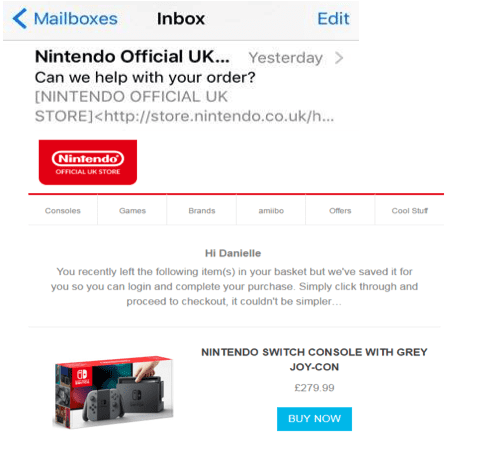
Nintendo saved the item in the shopping cart above and reminded the potential customer of their abandonment via email to encourage completion of the purchase. They also included the call to action button ‘buy now’, which leads directly to the landing page for finishing the order to simplify the checkout process further.
Retarget on Social
According to retargeting advertisement provider AdRoll, a mere 2% of shoppers actually convert on their first visit to an online store so brands must try to re-engage prospects where possible. Retargeting is a tremendously efficient method for re-engaging with prospects and achieving desired conversions. It provides marketers with the opportunity to nurture those who have previously visited their site but have subsequently decided to abandon their purchase for an unknown reason, increasing the chances of achieving an online sale from new or existing customers. Additionally, retargeting can also grow brand awareness, increase click-through rates, exposure and develop brand loyalty.
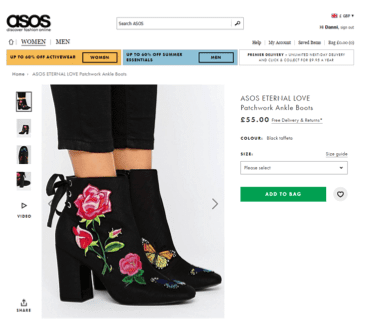
For example, let’s say after browsing on ASOS, a potential customer decided to add this pair of shoes to their shopping cart but decided to abandon the purchase - perhaps they were undecided about the item, or they are intending to complete the purchase later on. Sadly, these options increase the risk of them forgetting to buy the product completely.
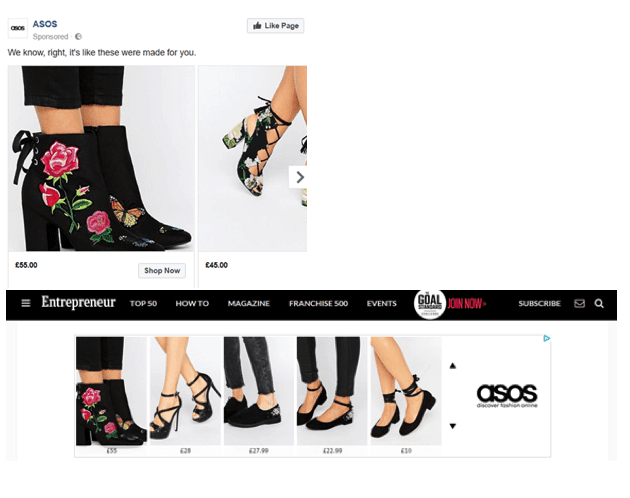

To remind and encourage the consumer to return and continue with the purchase, ASOS have used targeted adverts across social media and various websites to showcase this particular pair of shoes (see above). They have also featured similar shoes on this advert to increase their chances of upselling during a single purchase.
These retargeting campaigns result in high conversion rates because they’re personalised based on each customer’s preferences and recent behaviour. Additionally, the customers that generate the greatest revenues and margins are those that are active, so it’s best for your bottom line to keep buyers engaged and satisfied.
Guest Checkout
Despite the checkout process being a fantastic opportunity to collect consumer data, forcing customers to create an account with your online store can be a major deterrent to completing a purchase. As revealed in Business Insider’s shopping cart abandonment research, being forced to login or create an account to complete a purchase is stated by 28% of consumers as being one of the most frustrating reasons and often that resulted in purchase abandonment.
Providing the option for customers to complete the checkout process as a guest is one of the best ways to guarantee a sale. Admittedly, offering a guest checkout option will mean you’ll have to sacrifice consumer data for other marketing methods, but it will make the sales process substantially easier for your customers, which is exactly what they desire - the easier you make it for people to buy from you, the more sales you’ll generate.
However, if you offer as frictionless an online shopping experience as possible, you may find previous customers will be more willing to not only purchase from you again in the future but also create accounts to take advantage of loyalty programs and other incentives.
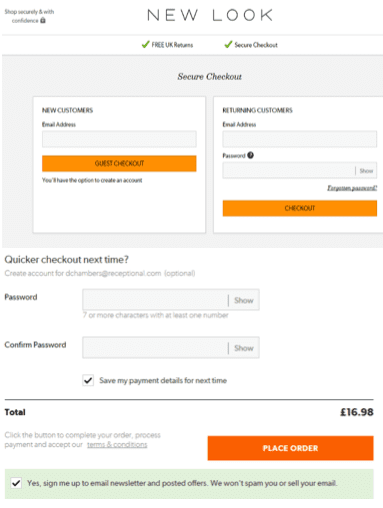
New Look allow their customers to complete an order by providing the option to create an account afterwards. By removing the element of force within their checkout process customers are far more likely to create an account of their own accord.
Simplify the Checkout Process
Every additional page requiring data input during the checkout allows more opportunity for a shopper to abandon their cart. Overall, around 27% of customers will give up on a purchase due to the complexity of the checkout process and the time required for completion. Multi-page checkouts that continuously present customers with additional forms, questions and products might be useful information for your business but it will simply result in frustration for your customers and cause them to buy from a competitor instead.
Ideally, a checkout process should consist of three to five steps. The shorter, the better. Remember - if you do try to shorten the process, make sure you’re not making a single step in the process consist of too many fields. The inclusion of a simple trail above your checkout (i.e. Delivery Info -> Payment -> Confirmation) will reduce cart abandonment further - customers want to know they’re not stuck in an interminable labyrinth of checkout stages.
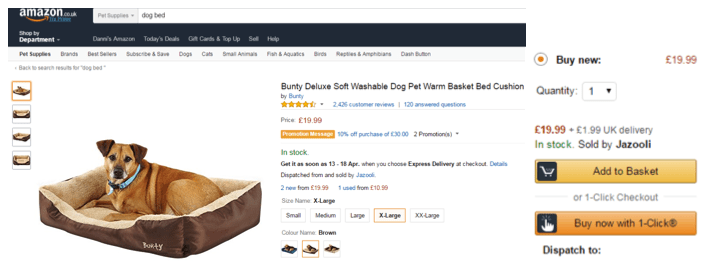
Amazon’s checkout system makes it possible for customers store personal, delivery and payment information within their account for later purchases. Once the details are saved in the account, customers can add items to their shopping basket and finish future orders instantaneously by clicking the ’buy now with 1 click’ call to action button.
Establish and Build Trust
It is easy to assume that transaction forms are a mere formality during the checkout stage - you’ve managed to tempt a customer enough to reach the point of finalising their purchase, so why wouldn’t they comply and fill out a lengthy form without hesitation or questioning? Sadly, this definitely isn’t the case: transaction forms are a crucial tool for establishing and building trust on your site.
By asking your customers to fill out a transaction form you’re essentially asking them to trust you with their personal information. This goes beyond their contact details; you’re asking for their card details - something many people are (understandably) hesitant to part with.

To offset the hesitation of handing over their financial identity, use your transaction forms as an opportunity to build and establish trust. Include trust seals (also known as SSL certificates) in a prominent position somewhere close to your transaction forms.
Free or Flat Shipping Costs
Looking at the extensive reasons behind shopping cart abandonment, half of consumers (50%) will leave a purchase because their order failed to qualify for free shipping; while 37% will exit the sales process if shipping prices were unclear until the final stage of the checkout.
It is vital that you’re as forthcoming about shipping costs as you possibly can be. Don’t try to sneak shipping costs in toward the end of a transaction: your customers deserve (and expect) better than this. Be upfront about how much it will cost for your customers to receive their items.
Another factor to consider with regard to shipping is delivery estimates. If you’ve ever been presented with a vague, indeterminate estimate of how long you can expect to wait before your package will arrive, you know how frustrating this can be.
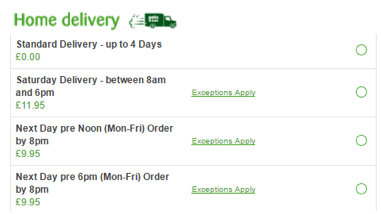
Pets at Home have made their shipping costs and estimated day of arrival extremely clear at the beginning of their checkout process. They have also increased the chances of customers selecting a paid delivery method instead of the free option by adding time of day estimates as this allows consumers to book deliveries to suit their convenience.















